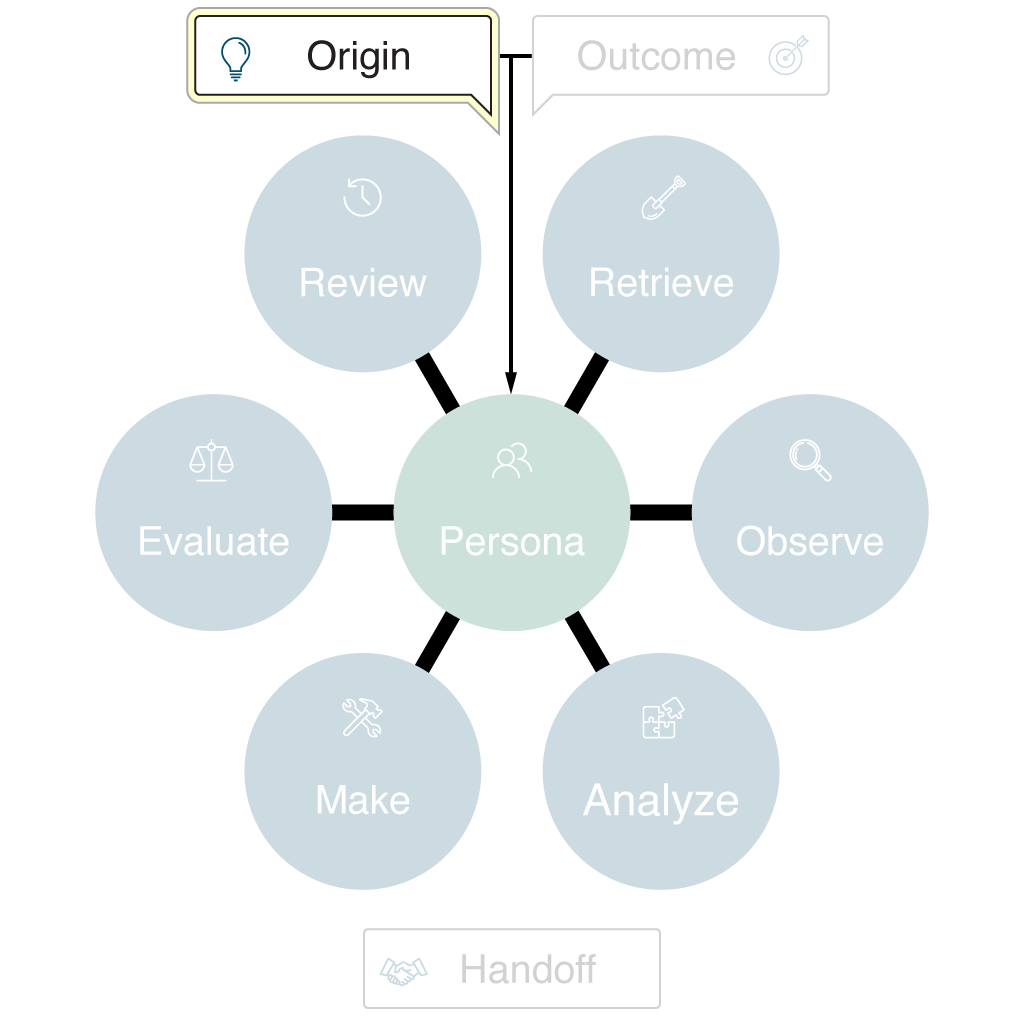
The Origin phase defines where the work begins and who is involved. This phase is your first and best opportunity to create alignment—by surfacing all catalysts, mapping every stakeholder, and setting transparent communication patterns across teams and groups. Starting with a clear origin ensures that collaboration and engagement are prioritized from the outset, preventing misalignment and missed expectations down the line.
Purpose
- Identify why this work is happening now
- Map out all stakeholders—primary and secondary, across teams, functions, and boundaries
- Establish shared expectations for engagement and communication, ensuring all voices are accounted for
- Foster early transparency, so every participant understands the context
and rationale
Key Questions
- Who initiated this work, and what prompted it?
- What are the business, market, or operational drivers?
- Who are the key stakeholders? Are there secondary influencers—across functions, groups, or even organizations?
- What are each stakeholder’s interests, expectations, and potential resistance points?
- How will stakeholders stay informed and engaged—especially those outside your core team?
- What frameworks (RACI, DACI, etc.) or communication protocols will be used to ensure cross-group clarity?
- Are there risks or dependencies tied to the origin—especially those related to stakeholder engagement or boundaries?
Read the research report on understanding the origin of work. [Document Link – PDF]
Case Study Example: Dog Park Finder App (Fetch Spotter)
Background: A regional pet care startup decides to build a mobile app to help dog owners find, rate, and review local dog parks.
Applying the Origin Phase:
Who initiated this work, and what prompted it?
- The Product Owner and Product Management team initiated the project.
- Response to frequent customer requests and low engagement with existing community features
What are the business, market, or operational drivers?
- Rising pet ownership
- Demand for pet-friendly amenities
- Competitors launching similar community-based features.
Who are the key stakeholders? Are there secondary influencers?
- Primary:
- Product Owner
- Engineering Lead
- Marketing Lead
- Customer Success Lead
- Secondary:
- Local dog park associations
- City recreation departments
- Early adopter dog owners
What are each stakeholder’s interests, expectations, and potential resistance points?
- Product:
- Fast launch
- Differentiation
- Engineering:
- Simplicity
- Scalability
- Marketing:
- App store visibility
- Viral sharing
- Customer Success:
- Quality onboarding
- Support workflows
- Dog park associations:
- Accurate info
- Positive community use
- City departments:
- Liability
- Privacy concerns
How will stakeholders stay informed and engaged?
- Bi-weekly project updates
- Kickoff and demo meetings
- Shared progress tracker
What frameworks or communication protocols will be used?
- RACI for roles
- Slack channel for daily questions
- Jira for task tracking.
Risks or dependencies?
- Access to up-to-date city park data
- Delays from city approval
- Competition from similar apps launching soon
| Role / Responsibility | Product Owner | Engineering Lead | Marketing Lead | Customer Success | Dog Park Associations | City Rec Dept | Early Adopter Dog Owners |
|---|---|---|---|---|---|---|---|
| Requirements Gathering | A | C | C | C | C | C | C |
| Solution Design | A | R | C | C | C | C | C |
| App Development | C | A/R | C | C | I | I | I |
| Go-to-Market Strategy | C | C | A/R | C | C | I | I |
| Onboarding & Support | C | C | C | A/R | I | I | C |
| Park Data Accuracy | C | C | C | C | A/R | R | I |
| User Feedback & Testing | C | C | C | C | I | I | A/R |
Example Figure: RACI Chart for Dog Park Finder App
R = Responsible, A = Accountable, C = Consulted, I = Informed
This RACI chart illustrates how different stakeholders are engaged in key activities during the Dog Park Finder App project. Adapt roles and activities to fit your context.

